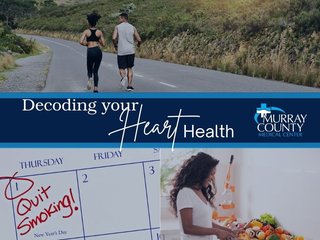Blog
Decoding your Heart Health

A Guide to Understanding your Cardiovascular Health
February is American Heart Month – A perfect time to focus on your cardiovascular health! Let’s explore some key factors that impact your heart and overall well-bring.
A key component that’s monitored often when it comes to your heart is your cholesterol levels. Cholesterol levels are monitored due to the risk of heart attack and stroke with higher levels of cholesterol. When reviewing lab work from a cholesterol screening, you’ll notice a few different results including total cholesterol, HDL cholesterol, LDL cholesterol, and triglycerides. HDL is considered “good” cholesterol as it helps move cholesterol away from your arteries where LDL is considered the “bad” cholesterol. Triglycerides are one of the most common fats in your body.
Another factor involved with cardiovascular health is blood pressure. Blood pressure is the force in which our blood pushes against the artery walls. High blood pressure often has no symptoms which makes it more difficult for people to recognize without getting consistent check-ups. Not monitoring and treating high blood pressure increases one’s risk of heart attack and stroke.
With both high cholesterol and high blood pressure, there are ways to help reduce your risks. Let’s look at some of those factors a little more:
- Physical Activity: Regular physical activity helps reduce your risk of cardiovascular concerns as well as other health risks. If you don’t already have a routine, start slowly and find something that you enjoy. Aim for at least 150 minutes of moderate intensity activity each week, or 30 minutes five days a week. Make sure not to push yourself too hard and never compare yourself to others.
- Healthy Eating: Aim to have a balanced, healthy diet. You can often tweak recipes that you currently enjoy with healthier substitutes. Take dairy for example, instead of using the full fat version, aim for the low fat or fat free option. You can also use salt-free seasonings as well as low-sodium broths where needed. Each person’s dietary needs are different so it’s important to learn what you may need. Once you know this, you can read food labels to make sure you’re gravitating towards the foods that are more accurate for you and your needs.
- Quit Smoking: Smoking affects your entire body including your cardiovascular system. Making the decision to quit smoking can be difficult, but it’s never too late to quit. Take time to decide what is the best plan for you and ask for help from your healthcare provider or family where needed. After quitting, over time, you may notice that you’ll be able to breathe easier, have a stronger sense of taste and smell, and you’ll decrease your risk for heart disease and stroke.
Making changes with your lifestyle habits can be overwhelming. Make changes gradually to help minimize that overwhelming feeling if needed. If you need additional support in the process, talk with those you live with. They may be willing to make changes with you and help you through those adjustments. At the end of the day, if you have concerns or questions, your Providers is a wonderful resource.